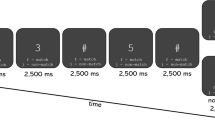Abstract
This study evaluated the effectiveness of fine motor physical activity with tactile stimulation during two conditions of math problem solving, visual and auditory. Eight 4th and 5th grade students with attention problems participated. Using an alternating treatments design, students solved as many math story problems as they could, presented on worksheets or verbally during two conditions, with and without tactile stimulation during 20 min. Motor behavior, recorded from videotape, and number of correctly completed word problems were measured. Results suggest that fine motor manipulation of a tactile stimulation object reduced excessive motor movement and increased task completion of students with attention problems.








Similar content being viewed by others
References
Abikoff, H., Courtney, M. E., Szeibel, P. J., & Koplewicz, H. S. (1996). The effects of auditory stimulation on the arithmetic performance of children with ADHD and nondisabled children. Journal of Learning Disabilities, 29, 238–246.
Bass, C. K. (1983). The effects of running on behavioral control of learning disabled children. Dissertation Abstracts International. AAT 8319360.
Belfiore, P. J., Grskovic, J. A., Murphy, A. M., & Zentall, S. S. (1996). The effects of antecedent color on reading for students with attention deficit hyperactivity disorder and learning disabilities. Journal of Learning Disabilities, 29, 432–438.
Conners, C. K. (1997). Conners’ ratings scales-revised: Technical manual. North Tonowanda, NY: Multi-Health Systems.
Douglas, V. I. (1989). Can Skinnerian theory explain attention deficit disorder? A reply to Barkley. In L. M. Bloomingdale, & J. Sergeant (Eds.), Attention deficit disorder: Current concepts and emerging trends in attentional and behavioral disorders of childhood (pp. 235–254). Elmsford, NY: Pergamon Press.
Faraone, S. V., Sergeant, J., Gillberg, C., & Biederman, J. (2003). The worldwide prevalence of ADHD: Is it an American condition? World Psychiatry, 2, 104–113.
Grskovic, J. A., Hall, A. M., Montgomery, D. J., Vargas, A. U., Zentall, S. S., & Belfiore, P. J. (2004). Reducing time-out assignments for students with emotional/behavioral disorders in a self-contained classroom: Class-wide implications. Journal of Behavioral Education, 13, 25–36.
Grskovic, J. A., & Zentall, S. S. (2007). The behavioral, social, and emotional characteristics and self-concepts of a school-based sample of girls with symptoms of ADHD (Manuscript in preparation).
Hebb, D. O. (1955). Drives and the CNS (conceptual nervous system). Psychological Review, 62, 243–254.
Lee, D. L., & Zentall, S. S. (2002). The effects of visual stimulation on the mathematics performance of children with attention deficit/hyperactivity disorder. Behavioral Disorders, 27, 272–288.
Leuba, C. (1955). Toward some integration of learning theories: The concept of optimal stimulation. Psychological Reports, 1, 27–33.
Michael, J. (2003). Concepts and principles of behavior analysis (2nd ed.). Kalamazoo MI: Association for Behavior Analysis.
Molloy, G. N. (1989). Chemicals, exercise, and hyperactivity. International Journal of Disability Development and Education, 1, 57–61.
Rivera, E., & Omizo, M. M. (1980). The effects of relaxation and biofeedback on attention to task and impulsivity among male hyperactivity children. Exceptional Children, 1, 41–51.
Rugel, R. P., Cheatam, D., & Mitchell, A. (1978). Body movement and inattention in learning disabled and normal children. Journal of Abnormal Child Psychology, 6, 325–337.
Tantillo, M., Kescik, C. M., Hynd, G. W., & Dishman, R. K. (2002). The effects of exercise on children with attention-deficit hyperactivity disorder. Medicine & Science in Sports & Exercise, 34, 203–212.
Welsh, M. C., & Labbé, E. E. (1994). Children and aerobic exercise: A review of cognitive and behavioral effects. Journal of Experimental Child Psychology, 58, 405–417.
Zentall, S. S. (2006). ADHD and education: Foundations, characteristics, methods, and collaboration. Upper Saddle River, NJ: Pearson Merrill Prentice Hall.
Zentall, S. S., & Dwyer, A. M. (1988). Color effects on the impulsivity and activity of hyperactive children. Journal of School Psychology, 27, 165–174.
Zentall, S. S., Grskovic, J., Javorsky, J., & Hall, A. M. (2000). Effects of noninformational color on reading test performance of students with attention deficit hyperactivity disorder (ADHD). Diagnostique, 25, 129–146.
Zentall, S. S., & Javorsky, J. (1995). Functional and clinical assessment of ADHD: Implications of DSM-IV in the schools. Journal of Psychoeducational Assessment: ADHD Special Monograph, 22–41.
Zentall, S. S., & Zentall, T. R. (1983). Optimal stimulation: A model of disordered activity and performance in normal and deviant children. Psychological Bulletin, 3, 446–471.
Acknowledgements
We would like to express our sincere gratitude and thanks to the administrators, counselors, teachers, parents and children from the Sugar Creek Elementary school—North Montgomery School Corporation, Crawfordsville, IN, who made this study possible.
Author information
Authors and Affiliations
Corresponding author
Rights and permissions
About this article
Cite this article
Kercood, S., Grskovic, J.A., Lee, D.L. et al. The effects of fine motor movement and tactile stimulation on the math problem solving of students with attention problems. J Behav Educ 16, 303–310 (2007). https://doi.org/10.1007/s10864-007-9042-1
Received:
Accepted:
Published:
Issue Date:
DOI: https://doi.org/10.1007/s10864-007-9042-1




